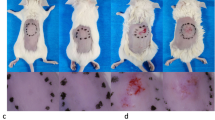Abstract
Impressic acid, 3α,11α-dihydroxylup-20(29)-en-28-oic acid, is a lupane-type triterpenoid isolated from Acanthopanax koreanum, which has been used as a Korean folk medicine for rheumatism, hepatitis, diabetes, and inflammatory disorders. Recently, it was reported that impressic acid has inhibitory effects on the LPS-stimulated pro-inflammatory cytokine production in bone marrow-derived dendritic cells and on the nuclear factor of activated T-cells transcription factor activity. Thus, to investigate whether impressic acid has effects on the inhibition of nuclear factor kappa B (NF-κB) and activation of peroxisome proliferator-activated receptor gamma (PPARγ), luciferase reporter assays were used. The effects on the expression of NF-κB and PPARγ target genes were also examined by reverse transcription-polymerase chain reaction. In this study, impressic acid was found to inhibit tumor necrosis factor (TNF)-α induced NF-κB activity and to up-regulate transcriptional activity of PPARγ.
Similar content being viewed by others
References
Cai, X. F., Lee, I. S., Shen, G., Dat, N. T., Lee, J. J., and Kim, Y. H., Triterpenoids from Acanthopanax koreanum root and their inhibitory activities on NFAT transcription. Arch. Pharm. Res., 27, 825–828 (2004).
Harada, K., Isse, K., Kamihira, T., Shimoda, S., and Nakanuma, Y., Th1 cytokine-induced downregulation of PPARγ in human biliary cells relates to cholangitis in primary biliary cirrhosis. Hepatology, 41, 1329–1338 (2005).
Kim, J. A., Yang, S. Y., Koo, J.-E., Koh, Y.-S., and Kim, Y. H., Lupane-type triterpenoids from the steamed leaves of Acanthopanax koreanum and their inhibitory effects on the LPS-stimulated pro-inflammatory cytokine production in bone marrow-derived dendritic cells. Bioorg. Med. Chem. Lett., 20, 6703–6707 (2010a).
Kim, K. K., Park, K. S., Song, S. B., and Kim, K. E., Up regulation of GW112 Gene by NF-κB promotes an anti-apoptotic property in gastric cancer cells. Mol. Carcinog., 49, 259–270 (2010b).
Klopotek, A., Hirche, F., and Eder, K., PPARγ ligand troglitazone lowers cholesterol synthesis in HepG2 and Caco-2 cells via a reduced concentration of nuclear SREBP-2. Exp. Biol. Med (Maywood)., 231, 1365–1372 (2006).
König, B., Koch, A., Spielmann, J., Hilgenfeld, C., Hirche, F., Stangl, G. I., and Eder, K., Activation of PPARα and PPARγ reduces triacylglycerol synthesis in rat hepatoma cells by reduction of nuclear SREBP-1. Eur. J. Pharmacol., 605, 23–30 (2009).
Kuo, Y.-H., Lo, J.-M., and Chan, Y.-F., Cytotoxic components from the leaves of Schefflera taiwaniana. J. Chin. Chem. Soc., 49, 427–431 (2002).
Michalik, L., Auwerx, J., Berger, J. P., Chatterjee, V. K., Glass, C, K., Gonzalez, F, J., Grimaldi, P. A., Kadowaki, T., Lazar, M. A., O’Rahilly, S., Palmer, C. N., Plutzky, J., Reddy, J. K., Spiegelman, B. M., Staels, B., and Wahli, W., International union of pharmacology. LXI. Peroxisome proliferator-activated receptors. Pharmacol. Rev., 58, 726–741 (2006).
Park, S. H., Nhiem, N. X., Kiem, P. V., Choi, E. M., Kim, J. A., and Kim, Y. H., A new norlupane triterpene from the leaves of Acanthopanax koreanum increases the differentiation of osteoblastic MC3T3-e1 cells. Arch. Pharm. Res., 33, 75–80 (2010).
Recio, M. C., Giner, R. M., Máñez, S., and RÍos, J. L. Structural requirements for the anti-inflammatory activity of natural triterpenoids. Planta Med., 61, 182–185 (1995).
Reyes, C. P., Núñez, M. J., Jiménez, I. A., Busserolles, J., Alcaraz, M. J., and Bazzocchi, I. L. Activity of lupane triterpenoids from Maytenus species as inhibitors of nitric oxide and prostaglandin E2. Bioorg. Med. Chem., 14, 1573–1579 (2006).
Srivastava, S. K., A new triterpenic acid from Schefflera impressa. J. Nat. Prod., 55, 298–302 (1992).
Tak, P. P. and Firestein, G. S., NF-κB: a key role in inflammatory diseases. J. Clin. Invest., 107, 7–11 (2001).
Ty, P. D., Lischewski, M., Phiet, H. V., Preiss, A., Sung, T. V., Schmidt, J., and Adam, G., Natural products from Vietnamese plants. Part 12. Two triterpenoid carboxylic acids from Acanthopanax trifoliatus. Phytochemistry, 23, 2889–2891 (1984).
Vandoros, G. P., Konstantinopoulos, P. A., Sotiropoulou-Bonikou, G., Kominea, A., Papachristou, G. I., Karamouzis, M. V., Gkermpesi, M., Varakis, I., and Papavassiliou, A. G., PPAR-γ is expressed and NF-κB pathway is activated and correlates positively with COX-2 expression in stromal myofibroblasts surrounding colon adenocarcinomas. J. Cancer Res. Clin. Oncol., 132, 76–84 (2006).
Author information
Authors and Affiliations
Corresponding author
Rights and permissions
About this article
Cite this article
Kim, J.A., Yang, S.Y., Song, S.B. et al. Effects of impressic acid from Acanthopanax koreanum on NF-κB and PPARγ activities. Arch. Pharm. Res. 34, 1347–1351 (2011). https://doi.org/10.1007/s12272-011-0815-7
Received:
Revised:
Accepted:
Published:
Issue Date:
DOI: https://doi.org/10.1007/s12272-011-0815-7




